| Revision as of 03:33, 26 November 2007 editDonreed (talk | contribs)7,544 edits →Impounds and Storage← Previous edit | Latest revision as of 10:49, 7 October 2024 edit undoKnitsey (talk | contribs)Extended confirmed users, Pending changes reviewers, Rollbackers28,147 edits Reverted 1 edit by Itcrewonline (talk): SpamTags: Twinkle Undo Mobile edit Mobile web edit Advanced mobile edit | ||
| (499 intermediate revisions by more than 100 users not shown) | |||
| Line 1: | Line 1: | ||
| {{Short description|Truck used to move motor vehicles}} | |||
| ] | |||
| {{About|vehicles used in towing|the album by The Perpetrators|Tow Truck (album)|general information|Towing|towing techniques|Vehicle recovery#Types of tow}} | |||
| {{Use American English|date=October 2020}} | |||
| ] tow truck]] | |||
| A '''tow truck''' (also called a '''wrecker''', a '''breakdown truck''', '''recovery vehicle''' or a '''breakdown lorry''') is a ] used to move disabled, improperly parked, ], or otherwise indisposed motor vehicles. This may involve recovering a vehicle damaged in an accident, returning one to a drivable surface in a mishap or inclement weather, or ] or transporting one via flatbed to a ] or other location. | |||
| A tow truck is distinct from a ], which is used to move multiple new or used vehicles simultaneously in routine transport operations. | |||
| A '''tow truck''' (also called a '''wrecker''', a '''breakdown truck''' or a '''breakdown lorry'''), is a vehicle used to take disabled ]s to another location (generally a repair ]) in case of ] or ], or to impound ] vehicles on public or (more commonly) private property. | |||
| ==History== | |||
| It is generally provided by an ] operator. | |||
| ] | |||
| ] of ] developed an ] for the ] in 1908, the ]. One of the batch was constructed as a recovery vehicle for the others, with a large winch on the rear platform.<ref>{{Cite book | |||
| |chapter=Chapter 2: Power to the Dual Monarchy | |||
| |title=Professor Porsche's Wars | |||
| |last=Ludvigsen |first=Karl | |||
| |author-link=Karl Ludvigsen | |||
| |year=2014 | |||
| |publisher=Pen & Sword Military | |||
| |isbn=978-1-52672-679-7 | |||
| |ref={{harvid|Ludvigsen, Professor Porsche's Wars}} | |||
| |pages=16, 18–19, 21 | |||
| }}</ref> | |||
| The wrecker (with lifting jib) was invented in 1916 by ] of ], a garage worker who was inspired after he needed ]s, ropes, and six men to pull a car out of a creek. After improving his design he began manufacturing them commercially.<ref name="Hall of fame">{{cite web|url=http://www.utc.edu/news07/ehf.php|title=Entrepreneurial Hall of fame inducts three|publisher=]|date=May 17, 2007|access-date=August 29, 2009|url-status=dead|archive-url=https://web.archive.org/web/20100623232310/http://www.utc.edu/news07/ehf.php|archive-date=June 23, 2010}}</ref> The ] in his home town displays restored antique wreckers, tools, equipment, and pictorial histories of motor-vehicle towing, a type of work that Holmes originated. | |||
| ==Types of Tow Trucks== | |||
| {{Clear|left}} | |||
| Five general types are in common usage, usually based on the type or size of vehicle to be towed ] ]: | |||
| ] | |||
| *'''Boom''' - not specifically for towing, many trucks are equipped with an adjustable boom winch for recovering vehicles that are in a ], ], over an ], or any place the vehicle cannot be safely backed-up to. | |||
| *'''] and ]''' (also known as a "sling" or "belt lift") - chains are looped around the vehicle frame or axle, which is drawn aloft by a boom winch to rest against a pair of heavy rubberized mats so the customer's vehicle can be towed on its other axle. Slings are not used much today because they can scratch the bumpers of cars. But they are sometimes used for towing vehicles that have been in an accident or have one or two of the front or rear wheels missing or for pickup trucks and other vehicles that have steel bumpers | |||
| *'''Wheel-Lift''' - evolved from the hook and chain technology to produce a large metal yoke that can be fitted under the front or rear wheels to cradle them, drawing the front or rear end of the vehicle clear of the ground by a pneumatic or hydraulic hoist so it can be towed. This apparatus generally picks up the drive wheels of the vehicle (ie the front wheels if it is front wheel drive, the rear wheels if it is rear wheel drive) touching only the tires. | |||
| *'''Flatbed''' (also called a Rollback or a Slide) - the entire back of the truck is fitted with a bed that can be hydraulically inclined and moved to ground level, allowing the customer's vehicle to be placed on it under its own power or pulled by a winch. | |||
| *'''Integrated''' (also referred to as a Snatcher or Repo Truck) - boom and wheel-lift integrated into one unit. Used predominantly to repossess vehicles or move illegally parked vehicles. Most have controls for the apparatus inside the cab of the tow truck to make quick pickup possible without the inconvenience of exiting the truck to hook up the vehicle. | |||
| == Types of towing equipment == | |||
| These are the most common arrangements, but are by no means exclusive, as there are flatbed units that offer a wheel-lift, boom trucks that can recover but not tow, and wheel-lift units that offer a combination boom with sling. | |||
| Five general types of tow truck are in common usage, usually based on the type or size of vehicle to be towed: | |||
| *Boom: uses an adjustable boom with a winch to recover vehicles from a ], over an ], or any place the vehicle cannot be safely reached by backing up. Some booms are fixed; some use heavy pivoting ]; others are equipped with hydraulic-powered ]s. The heaviest types of boom can rotate, effectively turning the tow truck into a sort of mobile crane, called a "rotator", and are usually reserved for incidents involving heavy vehicles.<ref>{{Cite news |url=https://www.caranddriver.com/features/challenger-rotator-9909 |title=Challenger Rotator 9909 {{!}} Feature {{!}} Features |work=Car and Driver |access-date=January 24, 2018}}</ref> In the past,{{Clarify timeframe|date=August 2021}} boom trucks used a "] and ]" system where chains are looped around the vehicle frame or axle, then lifted by a boom winch. A towbar with heavy rubberized mats connects the truck and vehicle, so it can be towed on its other axle. "Slings" and "belt lifts" are a further development, with rubber straps replacing part of the chains.<ref name=hdr>{{cite web |url=https://www.jerrdan.com/wp-content/uploads/manuals/maintenance/HDR%207085%20Wrecker%20Operations%20and%20Maintenance%20Manual.pdf|title=HDR 70/85 Wrecker Operations and Maintenance Manual |date=2010 |publisher=Jerr-Dan |access-date=13 September 2016 |pages=33–68}}</ref><ref name=cent>{{cite web |url=https://www.millerind.com/images/uploads/parts/century_820_iiit-parts-0500724-021997.pdf |title=Owner's Manual 820 Wrecker/FIIIT |date=1997 |publisher=Miller Industries |access-date=13 September 2016 |pages=III 1–5, IIIA 1–4, IV 1–8, IVA 1–20}}</ref><ref>{{cite web|url=https://www.jerrdan.com/wp-content/uploads/manuals/maintenance/Tow%20Sling%20Operation%20Supplement%20Manual.pdf|title=MPL Tow Sling Operation Supplement Manual|date=2007|publisher=Jerr-Dan|access-date=13 September 2016}}</ref> Slings are not used much today{{When|date=August 2021}}<!-- Since what year has this been the case? --> because they can scratch the bumpers of cars. However, they are sometimes used for towing vehicles that have been in an accident or have one or two of the front or rear wheels missing, or for pickup trucks and other vehicles that have steel bumpers. Cars equipped with ] cannot be towed with a sling, as it can cause problems with the car's drivetrain.<ref>{{cite web |url=http://auto.howstuffworks.com/auto-parts/towing/vehicle-towing/trailer/tow-four-wheel-drive-vehicle.htm|title=How to tow a four-wheel-drive vehicle|date=2 October 2008|publisher=]|access-date=9 April 2014}}</ref> | |||
| ==Operations== | |||
| * Wheel-lift (also called a "spectacle lift" or "underlift"): developed from the hook-and-chain technology to produce a large metal yoke that can be fitted under the front or rear wheels to cradle them, drawing the front or rear end of the vehicle clear of the ground by a pneumatic or hydraulic hoist so it can be towed. This apparatus generally picks up the drive wheels of the vehicle (i.e. the front wheels if it is front-wheel drive, the rear wheels if it is rear-wheel drive), touching only the tires.<ref name=cent/> The wheel lift was designed by Arthur W. Nelson of Weld Built Body Co. in 1967.<ref name="Automobile lift patent">{{cite patent|country=US|number=3434607 A|title=Automobile Towing device|status=patent}}. Retrieved 12 September 2016.</ref> The name ''spectacle lift'' is common in the UK; the cradle resembles a pair of squared spectacles (eyeglasses). Medium and heavy trucks use a variation, the "underlift" or "chassis lift", which lifts the axle or frame instead of the wheels. Wheel-lift trucks can have adapters which can also lift the chassis.<ref name=hdr/> | |||
| ] | |||
| * Integrated (also called a "self-loader", "snatcher", "quick pick" or "repo truck"): boom and wheel-lift integrated into one unit. Used in light-duty trucks to repossess vehicles or move illegally-parked vehicles. Most have controls for the apparatus inside the cab of the tow truck to make quick pickup possible without the inconvenience of exiting the truck to hook up the vehicle.<ref>{{cite web |url=http://www.metrotowtrucks.com/Wreckers/SL-3.aspx |title=SL3 Highspeed and volume (sales site) |date=2006|publisher=Metro tow Trucks |access-date=22 September 2016|archive-url=https://web.archive.org/web/20140701073129/http://www.metrotowtrucks.com/Wreckers/SL-3.aspx|archive-date=1 July 2014}}</ref><ref>{{cite web|url=https://patents.google.com/patent/US20050111948|title=US patent 20050111948 A1 Integrated boom, tow bar, and wheel lift tow truck assembly |date=20 November 2003|access-date=22 September 2016}}</ref> Though similar to a wheel-lift truck, an integrated truck differs in that the end of its boom features movable arms that can more easily and quickly clamp onto the wheels of a vehicle, often controlled from the cabin of the truck. On a wheel-lift truck, the wheels of a vehicle must be manually secured to the yoke by the operator before being lifted. There are also heavy-duty trucks manufactured with integrated lifts. | |||
| Tow trucks are usually operated by private businesses, except for major ]s and ]s, where the ] may operate the tow trucks for that stretch of road. Businesses who operate a large ], such as ] companies or package delivery services, often own one or several tow trucks for the purposes of ] their own vehicles. Government departments with large fleets (such as the ]s, ]s, transportation authorities and departments of public works of major cities) may similarly own tow truck(s). Police department tow trucks may also be used to ] other vehicles. | |||
| *Flatbed (also called a "rollback", "slide" or "tilt tray"): the entire back of the truck is fitted with a bed that can be hydraulically inclined and slid back to ground level, allowing the vehicle to be placed on it under its own power or pulled on by a winch.<ref>{{cite web|url=https://www.jerrdan.com/wp-content/uploads/Operation-Manual-5376000097-Standard-Medium-Heavy-Duty-Carrier-Rev3-9-14.pdf|title=Standard Duty Carrier Medium Duty Carrier Heavy Duty Carrier Operations and Maintenance Manual|date=2014|publisher=Jerr-Dan|access-date=13 Sep 2016}}</ref> Because they carry rather than tow the vehicle, they can be used on a completely immobile vehicle; in the US, they are used to carry badly-damaged cars from crashes. | |||
| *Lift flatbed: a boom uses a wheel-lift frame to lift the vehicle vertically and load it on the bed. This type of truck can remove vehicles that are parallel-parked. It is commonly used in Europe. | |||
| {{Multiple image | |||
| | total_width = 1200 | |||
| | align = centre | |||
| | caption_align = center | |||
| | image1 = Century 001.jpg | |||
| | caption1 = Boom truck with underlift | |||
| | image2 = AF79361 (Falck) (12.08.03) Balancer.jpg | |||
| | caption2 = Wheel-lift tow truck | |||
| | image3 = Modern Tow Trucks.jpg | |||
| | caption3 = Integrated tow truck | |||
| | image4 = Iveco Daily 70 C 17 Abschleppwagen (03).jpg | |||
| | caption4 = Flatbed with wheel-lift | |||
| | image5 = Tow truck in Moscow 01.jpg | |||
| | caption5 = Lift flatbed | |||
| }} | |||
| These are the most common arrangements; others also exist, such as flatbed units that offer a wheel-lift, boom trucks that can recover but not tow, and wheel-lift units that offer a combination boom with sling. | |||
| There are also several sizes and weight categories of tow truck. The lightest models are usually based on light truck and van chassis offering boom and tow weights of around {{convert|5|to(-)|10|ST|MT|abbr=off|sp=us}}, making them ideal for car towing. Medium-duty tow trucks have a boom capacity of {{convert|15|to(-)|20|ST|MT|abbr=off|sp=us}}. Heavy-duty tow trucks, based on chassis used by semi-trucks, with multiple axles and the ability to tow fully-loaded semi-truck and trailer combinations, have a boom capacity from {{convert|25|to(-)|50|ST|MT|abbr=off|sp=us}}. Rotators are the heaviest type of tow truck, ranging from {{convert|40|to(-)|75|ST|MT|abbr=off|sp=us}} (though lighter models do exist) and often come with many other features per customer specification.<ref>{{Cite web|url=https://qcode.us/codes/morenovalley/view.php?topic=12-12_14-12_14_080 |title=12.14.080 Tow truck classifications. |website=qcode.us|access-date=January 24, 2018}}</ref>{{Explain|date=August 2021|reason=What is the boom capacity range of rotators?}} | |||
| In the Australian states of New South Wales, Queensland and Victoria there exists a ], and tow trucks are identified by number plates ending in "TT". | |||
| Most flatbed-type vehicles are based on medium-duty and heavy-duty trucks to provide the chassis strength necessary to carry entire vehicles. | |||
| === Dispatching === | |||
| == Operations == | |||
| Requests for service are placed to a ] center. Some tow services communicate with drivers using ] ] equipment. In others, the dispatching center contacts an available tow truck driver via ] or by sending a text message using a ]. Recent technology includes the use of GPS and on board wireless equipment to dispatch drivers via a LCD screen receiver. | |||
| {{main|Towing}} | |||
| {{For|towing techniques|Vehicle recovery#Types of tow}} | |||
| ] | |||
| ]]] | |||
| ] | |||
| ].]] | |||
| ] | |||
| Tow trucks are usually operated by private businesses, except for major ]s and ]s, where the ] may operate the tow trucks for that stretch of road. Some police departments own tow trucks; in the US, however, it is common to contract police tows to private companies. Businesses who operate a large ], such as ] companies or package delivery services, often own one or several tow trucks for the purposes of ] their own vehicles. Government departments with large fleets (such as the ]s, ]s, transportation authorities and departments of public works of major cities) may similarly own one or more tow trucks. Police department tow trucks may also be used to ] other vehicles. Heavy tow trucks are often called to clear semi-truck accidents and straighten out ] trucks. In rural or unorganized areas, companies which operate tow trucks can sometimes also offer additional services appropriate to highway clearance where government-provided ones are unavailable, such as fire suppression. | |||
| The military also deploys tow trucks for ] of stranded vehicles. In the ], a variant of the ] truck is used for this purpose, the M984 wrecker.<ref>{{Cite web|url=https://www.military.com/equipment/heavy-expanded-mobility-tactical-truck|title=Heavy Expanded Mobility Tactical Truck|website=Military.com|access-date=January 24, 2018}}</ref> For recovery in combat situations while under fire, many armies with large vehicle fleets also deploy ]s. These vehicles fulfill a similar role, but are resistant to heavy fire and capable of traversing rough terrain with their ], as well as towing vehicles beyond the weight limits of wheeled wreckers, such as tanks (many are based on tank designs for this reason).<ref>{{Cite news|url=http://www.army-technology.com/projects/herculesrecoveryvehi/|title=M88A2 Hercules Armoured Recovery Vehicle |work=Army Technology|access-date=January 24, 2018}}</ref> | |||
| === Impounds and Storage === | |||
| ] | |||
| Many tow companies have the capability to store vehicles that have been wrecked or impounded by police agencies. In these circumstances, police agencies notify a contracted towing provider to secure the vehicle and tow it to a storage lot. The tow company will sometimes prevent access to the vehicle until the law states the owner can claim it (usually after any fines are paid). | |||
| Each state and territory of Australia has its own regulations and acts for the operation of tow trucks. Tow trucks are generally divided into two categories, either by standard, trade and private towing or accident towing. Accident towing tow trucks are clearly identifiable by number plates ending in either "ATT" or "TT". Tow trucks that are not endorsed for accident towing may use general number plates of any combination pursuant to each state's own registering system. An example of a statute regulating the operation of tow trucks and towing companies in ] is the Victorian ].<ref>{{Cite web|url=https://www.vicroads.vic.gov.au/business-and-industry/tow-truck-industry/information-for-the-towing-industry|title=Information for the towing industry|publisher=VicRoads|date=February 13, 2017|access-date=January 26, 2018}}</ref> | |||
| Nearly all tow companies charge a fee for storing vehicles. | |||
| Some jurisdictions may allow tow trucks to be considered as emergency vehicles, and use sirens, with the State of Missouri being a notable example.<ref>{{cite web|url=https://revisor.mo.gov/main/OneSection.aspx?section=304.022&bid=34605&hl=|title=Revised Statutes of Missouri, RSMo Section 304.022|publisher=Missouri Revisor of Statutes|access-date=December 13, 2023}}</ref> | |||
| In one surprising ] case, an ]-house landlord in ]—a city that took great pride in its high proportion of owner-occupied housing, and thus its ''low'' proportion of rentals—issued a single parking sticker for the tenants of each apartment: that is, one sticker per apartment, even if the apartment had multiple tenants. The stickers were issued in the name of a towing service—not the landlord. This sticker gave one driver permission to park one car in one preassigned parking space beneath the apartment. No provision was made for multiple tenants or guests—much less parties. The towing company did not wait for complaints but would send tow trucks cruising the parking garages, looking for business: if the driver found a car without the sticker or outside the prescribed place, the car was immediately towed to a distant, secure storage facility. No parking ticket was issued; no court was involved. A person whose car was towed could call a number and drive to a distant location in a low-rent neighborhood, then pay a hefty towing and storage charge, in cash. No option, no recourse, no appeal. One woman visited her sister's apartment for a few minutes and emerged to find her car missing. She told her sister and then learned the parking policy. She had a friend drive to the remote storage lot, found her car amid a sea of literal wrecks, and paid hundreds of dollars to ransom her car from these ingenious Silicon-Valley entrepreneurs. | |||
| == See also == | |||
| {{Portal|Transport}} | |||
| {{Commons category|Tow trucks}} | |||
| * ] | |||
| * ] | |||
| * ] | |||
| * ] | |||
| * ] | |||
| * ] | |||
| == References == | |||
| ]s are becoming more commonly used to tell the ] (of ] vehicles) to tow trucks. ] (AVL) systems are sometimes used to help the dispatch center staff determine the closest tow truck. AVL may use GPS technology. It may display the location of all tow trucks on a map or may feed data directly to a ] system which automatically recommends the closest available units. | |||
| {{Reflist}} | |||
| == |
== External links == | ||
| * in ]. | |||
| *] | |||
| *] | |||
| *]. | |||
| *] | |||
| *]. | |||
| *] | |||
| *] | |||
| {{Cranes}} | |||
| == Movie characters == | |||
| {{Automobile configuration}} | |||
| *] - An ] tow truck from the ] ] ], voiced by ] | |||
| {{Authority control}} | |||
| == External links == | |||
| * – Located in ]; birthplace of the tow truck. | |||
| * – Tips for safely operating a tow truck and towing an auto. | |||
| * | |||
| * | |||
| ] | |||
| ] | ] | ||
| ] | ] | ||
| ] | |||
| ] | |||
| ] | |||
| ] | |||
| ] | |||
Latest revision as of 10:49, 7 October 2024
Truck used to move motor vehicles This article is about vehicles used in towing. For the album by The Perpetrators, see Tow Truck (album). For general information, see Towing. For towing techniques, see Vehicle recovery § Types of tow.
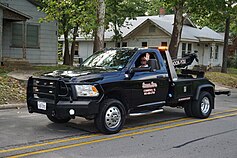
A tow truck (also called a wrecker, a breakdown truck, recovery vehicle or a breakdown lorry) is a truck used to move disabled, improperly parked, impounded, or otherwise indisposed motor vehicles. This may involve recovering a vehicle damaged in an accident, returning one to a drivable surface in a mishap or inclement weather, or towing or transporting one via flatbed to a repair shop or other location.
A tow truck is distinct from a car carrier trailer, which is used to move multiple new or used vehicles simultaneously in routine transport operations.
History

Ferdinand Porsche of Austro-Daimler developed an artillery tractor for the Austro-Hungarian army in 1908, the M 08. One of the batch was constructed as a recovery vehicle for the others, with a large winch on the rear platform.
The wrecker (with lifting jib) was invented in 1916 by Ernest Holmes Sr. of Chattanooga, Tennessee, a garage worker who was inspired after he needed blocks, ropes, and six men to pull a car out of a creek. After improving his design he began manufacturing them commercially. The International Towing and Recovery Hall of Fame and Museum in his home town displays restored antique wreckers, tools, equipment, and pictorial histories of motor-vehicle towing, a type of work that Holmes originated.
Types of towing equipment
Five general types of tow truck are in common usage, usually based on the type or size of vehicle to be towed:
- Boom: uses an adjustable boom with a winch to recover vehicles from a ditch, over an embankment, or any place the vehicle cannot be safely reached by backing up. Some booms are fixed; some use heavy pivoting A-frames; others are equipped with hydraulic-powered telescopic cylinders. The heaviest types of boom can rotate, effectively turning the tow truck into a sort of mobile crane, called a "rotator", and are usually reserved for incidents involving heavy vehicles. In the past, boom trucks used a "hook and chain" system where chains are looped around the vehicle frame or axle, then lifted by a boom winch. A towbar with heavy rubberized mats connects the truck and vehicle, so it can be towed on its other axle. "Slings" and "belt lifts" are a further development, with rubber straps replacing part of the chains. Slings are not used much today because they can scratch the bumpers of cars. However, they are sometimes used for towing vehicles that have been in an accident or have one or two of the front or rear wheels missing, or for pickup trucks and other vehicles that have steel bumpers. Cars equipped with all-wheel drive cannot be towed with a sling, as it can cause problems with the car's drivetrain.
- Wheel-lift (also called a "spectacle lift" or "underlift"): developed from the hook-and-chain technology to produce a large metal yoke that can be fitted under the front or rear wheels to cradle them, drawing the front or rear end of the vehicle clear of the ground by a pneumatic or hydraulic hoist so it can be towed. This apparatus generally picks up the drive wheels of the vehicle (i.e. the front wheels if it is front-wheel drive, the rear wheels if it is rear-wheel drive), touching only the tires. The wheel lift was designed by Arthur W. Nelson of Weld Built Body Co. in 1967. The name spectacle lift is common in the UK; the cradle resembles a pair of squared spectacles (eyeglasses). Medium and heavy trucks use a variation, the "underlift" or "chassis lift", which lifts the axle or frame instead of the wheels. Wheel-lift trucks can have adapters which can also lift the chassis.
- Integrated (also called a "self-loader", "snatcher", "quick pick" or "repo truck"): boom and wheel-lift integrated into one unit. Used in light-duty trucks to repossess vehicles or move illegally-parked vehicles. Most have controls for the apparatus inside the cab of the tow truck to make quick pickup possible without the inconvenience of exiting the truck to hook up the vehicle. Though similar to a wheel-lift truck, an integrated truck differs in that the end of its boom features movable arms that can more easily and quickly clamp onto the wheels of a vehicle, often controlled from the cabin of the truck. On a wheel-lift truck, the wheels of a vehicle must be manually secured to the yoke by the operator before being lifted. There are also heavy-duty trucks manufactured with integrated lifts.
- Flatbed (also called a "rollback", "slide" or "tilt tray"): the entire back of the truck is fitted with a bed that can be hydraulically inclined and slid back to ground level, allowing the vehicle to be placed on it under its own power or pulled on by a winch. Because they carry rather than tow the vehicle, they can be used on a completely immobile vehicle; in the US, they are used to carry badly-damaged cars from crashes.
- Lift flatbed: a boom uses a wheel-lift frame to lift the vehicle vertically and load it on the bed. This type of truck can remove vehicles that are parallel-parked. It is commonly used in Europe.
 Boom truck with underlift
Boom truck with underlift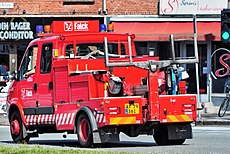 Wheel-lift tow truck
Wheel-lift tow truck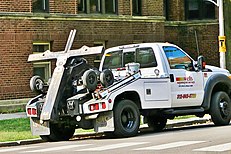 Integrated tow truck
Integrated tow truck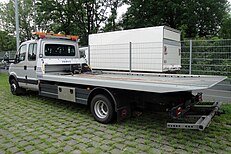 Flatbed with wheel-lift
Flatbed with wheel-lift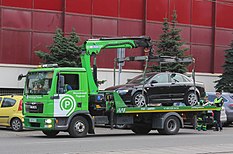 Lift flatbed
Lift flatbed
These are the most common arrangements; others also exist, such as flatbed units that offer a wheel-lift, boom trucks that can recover but not tow, and wheel-lift units that offer a combination boom with sling.
There are also several sizes and weight categories of tow truck. The lightest models are usually based on light truck and van chassis offering boom and tow weights of around 5 to 10 short tons (4.5–9.1 metric tons), making them ideal for car towing. Medium-duty tow trucks have a boom capacity of 15 to 20 short tons (14–18 metric tons). Heavy-duty tow trucks, based on chassis used by semi-trucks, with multiple axles and the ability to tow fully-loaded semi-truck and trailer combinations, have a boom capacity from 25 to 50 short tons (23–45 metric tons). Rotators are the heaviest type of tow truck, ranging from 40 to 75 short tons (36–68 metric tons) (though lighter models do exist) and often come with many other features per customer specification.
Most flatbed-type vehicles are based on medium-duty and heavy-duty trucks to provide the chassis strength necessary to carry entire vehicles.
Operations
Main article: Towing For towing techniques, see Vehicle recovery § Types of tow.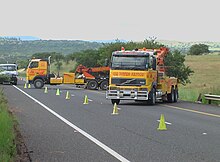
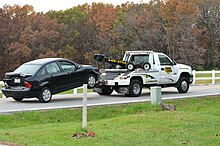

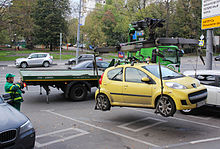

Tow trucks are usually operated by private businesses, except for major highways and toll roads, where the road authority may operate the tow trucks for that stretch of road. Some police departments own tow trucks; in the US, however, it is common to contract police tows to private companies. Businesses who operate a large fleet of vehicles, such as school bus companies or package delivery services, often own one or several tow trucks for the purposes of towing their own vehicles. Government departments with large fleets (such as the police departments, fire departments, transportation authorities and departments of public works of major cities) may similarly own one or more tow trucks. Police department tow trucks may also be used to impound other vehicles. Heavy tow trucks are often called to clear semi-truck accidents and straighten out jackknifed trucks. In rural or unorganized areas, companies which operate tow trucks can sometimes also offer additional services appropriate to highway clearance where government-provided ones are unavailable, such as fire suppression.
The military also deploys tow trucks for recovery of stranded vehicles. In the US Army, a variant of the HEMTT truck is used for this purpose, the M984 wrecker. For recovery in combat situations while under fire, many armies with large vehicle fleets also deploy armoured recovery vehicles. These vehicles fulfill a similar role, but are resistant to heavy fire and capable of traversing rough terrain with their tracks, as well as towing vehicles beyond the weight limits of wheeled wreckers, such as tanks (many are based on tank designs for this reason).
Each state and territory of Australia has its own regulations and acts for the operation of tow trucks. Tow trucks are generally divided into two categories, either by standard, trade and private towing or accident towing. Accident towing tow trucks are clearly identifiable by number plates ending in either "ATT" or "TT". Tow trucks that are not endorsed for accident towing may use general number plates of any combination pursuant to each state's own registering system. An example of a statute regulating the operation of tow trucks and towing companies in Victoria is the Victorian Accident Towing Services Act.
Some jurisdictions may allow tow trucks to be considered as emergency vehicles, and use sirens, with the State of Missouri being a notable example.
See also
- Armored recovery vehicle
- Impounded vehicle auction
- Motor carrier
- Roadside assistance
- Tow hitch
- Vehicle recovery
References
- Ludvigsen, Karl (2014). "Chapter 2: Power to the Dual Monarchy". Professor Porsche's Wars. Pen & Sword Military. pp. 16, 18–19, 21. ISBN 978-1-52672-679-7.
- "Entrepreneurial Hall of fame inducts three". University of Tennessee at Chattanooga. May 17, 2007. Archived from the original on June 23, 2010. Retrieved August 29, 2009.
- "Challenger Rotator 9909 | Feature | Features". Car and Driver. Retrieved January 24, 2018.
- ^ "HDR 70/85 Wrecker Operations and Maintenance Manual" (PDF). Jerr-Dan. 2010. pp. 33–68. Retrieved 13 September 2016.
- ^ "Owner's Manual 820 Wrecker/FIIIT" (PDF). Miller Industries. 1997. pp. III 1–5, IIIA 1–4, IV 1–8, IVA 1–20. Retrieved 13 September 2016.
- "MPL Tow Sling Operation Supplement Manual" (PDF). Jerr-Dan. 2007. Retrieved 13 September 2016.
- "How to tow a four-wheel-drive vehicle". HowStuffWorks. 2 October 2008. Retrieved 9 April 2014.
- A US patent 3434607 A, "Automobile Towing device" . Retrieved 12 September 2016.
- "SL3 Highspeed and volume (sales site)". Metro tow Trucks. 2006. Archived from the original on 1 July 2014. Retrieved 22 September 2016.
- "US patent 20050111948 A1 Integrated boom, tow bar, and wheel lift tow truck assembly". 20 November 2003. Retrieved 22 September 2016.
- "Standard Duty Carrier Medium Duty Carrier Heavy Duty Carrier Operations and Maintenance Manual" (PDF). Jerr-Dan. 2014. Retrieved 13 Sep 2016.
- "12.14.080 Tow truck classifications". qcode.us. Retrieved January 24, 2018.
- "Heavy Expanded Mobility Tactical Truck". Military.com. Retrieved January 24, 2018.
- "M88A2 Hercules Armoured Recovery Vehicle". Army Technology. Retrieved January 24, 2018.
- "Information for the towing industry". VicRoads. February 13, 2017. Retrieved January 26, 2018.
- "Revised Statutes of Missouri, RSMo Section 304.022". Missouri Revisor of Statutes. Retrieved December 13, 2023.
External links
| Types of cranes | |
|---|---|